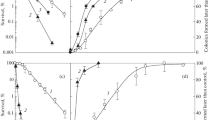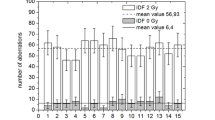Abstract
This study presents new experimental data demonstrating the recovery of irradiated cells in a nutrition medium that is usually associated with proliferation retardation. The effect of such recovery on the radiosensitivity of diploid yeast cells of different strains after ionizing and UV irradiation was determined by a previously described method. Observed increase of radiosensitivity was shown to be much higher than expected after the inhibition of recovery after potentially lethal damage. The data show that the inhibition of cells ability to recover after potentially lethal damages after incubation of irradiated cells in a nonnutrition medium can in many cases be an indicator of suppression of the total cells’ ability to recover. Presented experimental data indicate that this rule is not universal.
Similar content being viewed by others
References
Choy, H., Chemoradiation in Cancer Therapy, Totowa, NJ, USA: Humana Press, 2003.
Frankenberg, D., Frankenberg-Schwager, M., Blöcher, D., and Harbich, R., Evidence for DNA double-strand breaks as the critical lesions in yeast cells irradiated with sparsely or densely ionizing radiation under oxic or anoxic conditions, Radiat. Res., 1981, vol. 88, no. 3, pp. 524–532.
Hall, E.J. and Giaccia, A.J., Radiobiology for the Radiologist, Philadelphia: Lippincott Williams and Wilkins, 2006.
Kapultsevich, Yu.G., Petin, V.G., Korogodina, Yu.V., and Korogodin, V.I., Estimation of the contribution of postradiation recovery in the radiosensitivity of yeast cells, Izv. AN SSSR, Ser. Biol., 1974, vol. 4, pp. 549–562.
Kim, J.K., Komarova, L.N., Tkhabisimova, M.D., and Petin, V.G., Inhibition of recovery from potentially lethal damage by chemicals in Chinese hamster cells is realized through the production of irreversible damage, KoreanJ. Environ. Biol., 2005, vol. 23, no. 4, pp. 390–397.
Kim, J.K., Petin, V.G., and Tkhabisimova, M.D., Survival and recovery of yeast cells after simultaneous treatment of UV light radiation and heat, Photochem. Photobiol., 2004, vol. 79, no. 4, pp. 349–355.
Komarova, L.N., Petin, V.G., and Tkhabisimova, M.D., Recovery of yeast cells after exposure to ionizing radiation and hyperthermia, Radiat. Biol. Radioecol., 2002, vol. 42, no. 1, pp. 54–59.
Korogodin, V.I., Problemy postradiatsionnogo vosstanovleniya (Problems of Postirradiation Recovery), Moscow: Atomizdat, 1966.
Kumar, A., Kiefer, J., Schneider, E., and Crompton, N.E.A., Inhibition of recovery from potentially lethal damage by chemicals in Chinese hamster V79 A cells, Radiat. Environ. Biophys., 1985a, vol. 24, no. 2, pp. 89, no. 98.
Kumar, A., Kiefer, J., Schneider, E., and Crompton, N.E.A., Enhanced cell killing, inhibition of recovery from potentially lethal damage and increased mutation frequency by 3-aminobenzamide in Chinese hamster V79 A cells exposed to X-rays, Int. J. Radiat. Biol., 1985b, vol. 47, no. 1, pp. 103–112.
Little, J.B., Ueno, A.M., and Dahlberg, W.K., Differential response of human and rodent cell lines to chemical inhibition of the repair of potentially lethal damage, Radiat. Environ. Biophys., 1989, vol. 28, no. 3, pp. 193–202.
Luchnik, A.N., Glaser, V.M., and Shestakov, S.V., Repair of DNA double-strand breaks requires two homologous DNA duplexes, Mol. Biol. Repts., 1977, vol. 3, no. 6, pp. 437–442.
Petin, V.G. and Kim, J.K., Survival and recovery of yeast cells after combined treatments with ionizing radiation and heat, Radiat. Res., 2004, vol. 161, pp. 56–63.
Petin, V.G. and Kim, J.K., Synergistic Interaction and Cell Responses to Environmental Factors, New York: Nova Sciences Publishers, 2014.
Streffer, C. and Müller, W.U., Radiation risk from combined exposure to ionizing radiation and chemicals, Adv. Rad. Biol., 1984, vol. 11, pp. 173–210.
Streffer, C., Vauper, P., and Hahn, G., Biological Basis of Oncologic Thermotherapy, Berlin: Springer Verlag, 1990.
Tkhabisimova, M.D., Komarova, L.N., and Petin, V.G., Dark recovery of diploid yeast cells after simultaneous exposure to UV-irradiation and hyperthermia, Tsitologiia, 2002, vol. 44, no. 6, pp. 555–560.
Yarmonenko, S.P., Konoplyannikov, A.G., and Vaynson, A.A., Klinicheskaya radiobiologiya (Clinical Radiobiology), Moscow: Meditsina, 1992.
Zhestyanikov, V.D., Vosstanovlenie i radiorezistentnost' kletok (Cell Recovery and Radioresistance), Leningrad: Nauka, 1968.
Author information
Authors and Affiliations
Corresponding author
Additional information
Original Russian Text © E.S. Evstratova, V.G. Petin, 2015, published in Tsitologiya, 2015, Vol. 57, No. 6, pp. 422–427.
To the memory of V.D. Zhestyanikov.
Rights and permissions
About this article
Cite this article
Evstratova, E.S., Petin, V.G. Increase in radiosensitivity of cells after inhibition of their ability to repair after potentially lethal irradiation damage. Cell Tiss. Biol. 9, 462–466 (2015). https://doi.org/10.1134/S1990519X15060024
Received:
Published:
Issue Date:
DOI: https://doi.org/10.1134/S1990519X15060024




